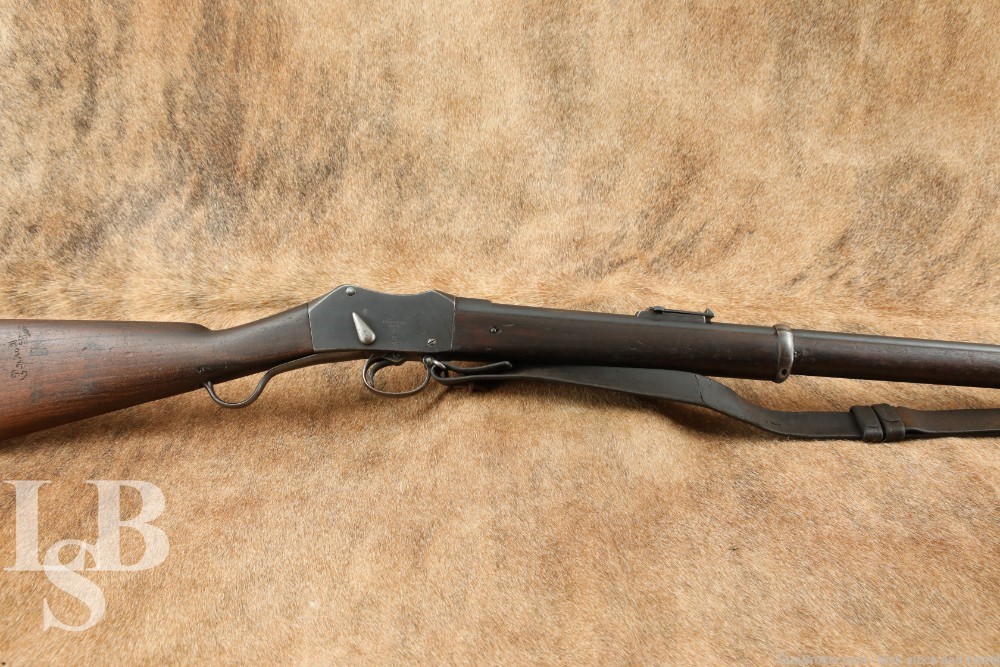
Nepalese Enfield Martini-Henry Mk. II Type 2 .577 Falling Block Rifle Antiq
SOLD FOR; $1,081.00
LSB#: WY241114DL006
Make: Royal Manufactory Enfield
Model: Martini-Henry Mk. II Type 2
Serial Number: M2783
Year of Manufacture: 1875
Caliber: .577/450 Martini–Henry
Action Type: Falling block, Single Shot, Lever break
Markings: The right side of the receiver is marked with a crown stamp over “V.R”, “Enfield.”, “1875.”, with a small proof mark, and “II.”, “2.”. The barrel shank is marked with various proofs and the serial number. The right side of the stock has a myriad of proofs and cartouches. The barrel is marked, “N E P N S”
Barrel Length: 33.25”
Sights / Optics: The front sight is a shallow blade on a square base. The rear sight is a v-notch blade when down and a sliding v-notch blade on a ladder when flipped up.
Stock Configuration & Condition: The two-piece wood stock has a straight grip, metal nose cap, cut out for the included cleaning rod, barrel band with bayonet lug & sling loop, barrel band, trigger guard mounted sling loop, lever rest, and a checkered metal buttplate. The buttplate has oxidation and minor erosion throughout. There are compression marks, scuffs, and scratches throughout the wood. There are no cracks but there are some chips at the edges and some larger ones throughout. There is light wear along the cleaning rod channel. The LOP measures 14.5” from the front of the trigger to the back of the buttplate. The stock rates in about Very Good overall condition as an Antique.
Type of Finish: Blued
Finish Originality: Original
Bore Condition: The bore is semi-bright and the rifling is sharp and well defined. There is some light erosion in the bore. In this writer’s opinion the bore rates 9/10 for Antique.
Most antique firearms have bores that will show erosion. This is not only due to age but also to the use of black powder. When fired, black powder reacts corrosively. NRA Antique Firearm Conditions Standards are quite lenient for bores. In some cases, the NRA standards disregarded the bore’s condition for collector’s firearms.
Overall Condition: This rifle retains about 40% of its metal finish. There is moderate patina throughout with scratches and small nicks throughout. There are small spots of rust throughout. There are moderate handling and wear marks throughout. The action has moderate wear. The screw heads are mostly sharp with some damaged ones. The pins have light marring. The markings are mostly clear. Overall, this rifle rates in about Very Good condition.
Mechanics: The action functions correctly. We did not fire this rifle. As with all used firearms, a thorough cleaning may be necessary to meet your maintenance requirements.
Box, Paperwork & Accessories: Leather sling.
Our Assessment: The Nepalese Enfield Martini-Henry Mk. II Type 2 in .577/450 Martini-Henry is a significant artifact of 19th-century firearms design, reflecting both the technological advances of the era and the global reach of British military influence. Adopted and manufactured under license by Nepal, this single-shot falling block rifle showcases the durability and simplicity that made the Martini-Henry a trusted tool for soldiers around the world. The Mk. II variant introduced several refinements over its predecessor, including improved extractor mechanisms and strengthened components, ensuring reliable performance in the field. Chambered in the powerful .577/450 Martini-Henry cartridge, this rifle was well-suited for the challenges of military service and colonial expeditions. The falling block action, celebrated for its robust and straightforward design, offered ease of use and maintenance, making it a practical choice for both seasoned troops and less-experienced personnel. This combination of power, reliability, and simplicity cemented the Martini-Henry’s reputation as one of the Victorian military’s most iconic firearms.
For collectors and history enthusiasts, the Nepalese Martini-Henry Mk. II Type 2 offers a rare opportunity to own a piece of firearm history with connections to both British and Nepalese military traditions. Many of these rifles were stored in Nepalese armories for decades, preserving their historical integrity and offering insight into 19th-century arms production and distribution. Whether valued for its mechanical ingenuity, its historical role in the expansion of the British Empire, or its association with Nepal’s military history, this rifle is a fascinating addition to any collection. It embodies the enduring legacy of the Martini-Henry as a symbol of the transition from muzzleloading to modern breechloading military rifles. -R.E.

